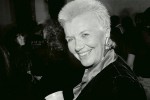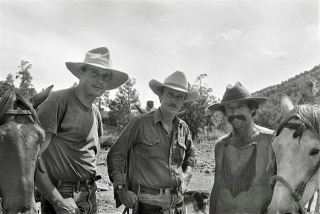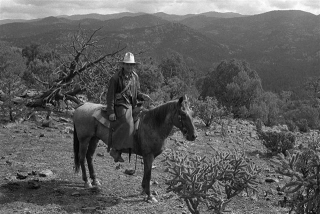Jim Brozek
Inspired by people at work, Brozek has for decades captured laborers of all kinds in his photos.
On October 18, Gallery Night, floor two of the prestigious Grohmann Museum at the Milwaukee School of Engineering was packed with folks who’d come to view the black- and-white photographs of Jim Brozek. In the crowd was Dr. Eckhart Grohmann himself, the founder of the great space at 1025 N. Broadway, and the force behind their collection dedicated to images of working people.
From now through December 13, it’s the perfect venue for “A Working Ranch.” As a tender 29-year-old armed with a Honeywell Pentax Spotmatic and a BBA from UW-Milwaukee, Brozek arrived at the ranch in southwestern New Mexico in the late 1970s, determined to immerse himself in life on a hard-scrabble working ranch, where “if you didn’t work you didn’t eat.” This and more poured forth from Brozek during a folksy talk back with Grohmann Director, James Keiselburg, at the Gallery Night event.
Unlike the photographers who influenced his career choice, stalwarts of the profession Dorthea Lange, Lewis Hine, and Walker Evans, Brozek wasn’t seeking social change via his images. He already knew, and had more or less shaped his vision for the future. His photography would be about “work,” and the physical elation that comes from hard labor.
Since age 12 when he had a paper route, and through his years of living on the near South Side with his Polish/German parents and two siblings, Brozek took note of the connection between work and survival. He was on his way to learning that photography was his way of surviving some challenging work environments.
One of his early jobs was so intense that workers were given a fifteen minute break, each and every half hour. One such hell hole was the now-defunct Wesley Heat Treating near 14th and Bruce streets. He worked his way through UW-Milwaukee as a truck loader for UPS and at Babcock and Wilcox, where all kinds of steel pipes were produced. Along the way, he humped for Stein Garden Center near 27th and Howard, when Stein was the only game in town. He earned $1.25 per hour, but there was a plus when he got to drive the boss’ Corvette Stingray.
“My dad was a blue-collar guy who worked for Nordberg,” he says. “In the evenings, he labored toward his Associate degree in engineering from MSOE. He was forever working.”
And though Brozek worked hard, it was through this experience (gratifying to both body and spirit) that he gradually shaped a philosophy welded to the pursuit of craftsmanship.
Not every job was a good fit, however. One such was selling shoes at Bakers, where the odor of feet didn’t quite inspire him in the same way as light streaming through dirty factory windows. But he forged ahead by always looking, seeing, and then seeing more, and he wonders if perhaps he’s been a photographer all of his life, gathering work images in his head and filing them for later use in his career. Certainly there’s an elegant use of light and shadow in his “A Working Ranch” exhibition.
Even his 1960 experience as a boy riding a Raspberry Roan in northern Wisconsin paid off, helping him adjust to life in the saddle on the ranch in New Mexico. Happily, his ranch photographs have found their way into a smartly-styled book, available at the Grohmann Museum.
There’s more to enjoy at www.jimbrozek.com/Photography, which offers photos of harvesters, dancers and bulk cargo carriers, as well as other topics. Brozek was chosen to photographically document the construction of the Milwaukee Art Museum’s Calatrava addition and is now doing similar work documenting the creation of John Shannon’s new art center in the Menomonee Valley.
It’s rewarding to see that many of those who came to view his work on that evening are themselves artists, and more specifically photographers of note. The crowd was mature and focused on the art rather than the wine and appetizers. Brozek is hopeful that the photographs will travel to other venues, but in the meantime, he’ll continue earning his daily bread by working at Marquette University.
He told me that the sign outside his door at work reads “Photographer.”
City People
-
New Public Allies Leader Comes Full Circle
 Nov 2nd, 2021 by Sam Woods
Nov 2nd, 2021 by Sam Woods
-
Dr. Lester Carter, a Community Anchor for 47 Years
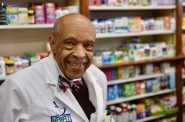 Jul 2nd, 2021 by Damia S. Causey
Jul 2nd, 2021 by Damia S. Causey
-
Reuben Harpole Found His Purpose
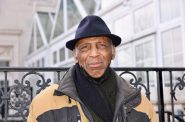 May 13th, 2021 by PrincessSafiya Byers
May 13th, 2021 by PrincessSafiya Byers

